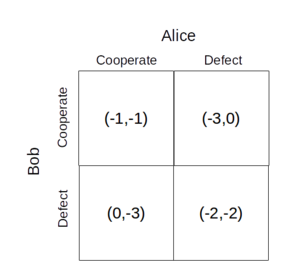Game theory is actually a study of mathematical models of conflict and cooperation between intelligent rational decision-makers. It’s mainly used in economics with respect to Bitcoin by using a system of work, incentives, and rewards that influence entities to perform a job which benefits the Bitcoin economy.
Game theory gets incredible complex, as outlined by Viktor Makarskyy of the National Center for Supercomputer Applications. It uses equations to predict behavior in a given situation. Two variables are the players and the game. Who are the players? Which game are they playing?
The game is the scenario, represented by a box. The players are represented by the X and Y axis. Then, a question can be posed and decisions by the players can be predicted based on how each party would react (assuming they react in the way that is most beneficial to themselves).
Here’s an example:
Game Theory in Bitcoin:
In Bitcoin, the Game is the Bitcoin code. The players are the miners and the users (nodes). People who use Bitcoin are essentially subsidizing electricity (computer processing power) from miners in order to send and receive Bitcoins and to secure the network which ensures that transactions cannot be dishonest and that Bitcoins cannot be copied.
The Players: Who are the Bitcoin miners?
A Bitcoin miner is someone who runs the Bitcoin program on their computer. That program verifies transactions and groups them together and adds them to an online ledger which is copied by everyone else who runs the Bitcoin program. All of these ledgers are identical.
When a miner adds a group of transactions to the ledger, they get rewarded with Bitcoin by the program. In other words, Bitcoin gets created out of nothing and delivered by the program to the miner who verifies the group of transactions (to make sure they’re honest transactions and can be spent). Each group of transactions is called a ‘block’. This is where we get the word ‘blockchain’. All of these groups of transactions are linked together, one after another, on this ledger.
Although many miners are running the Bitcoin program, online one miner in the entire world, every 10 minutes, is able to add a block to the blockchain.
Which miner gets to add a block to the blockchain?
How are they chosen?
The miners who run the Bitcoin program are racing. They need to solve a very difficult math problem which can only be solved by guessing a number, plugging it into the equation, and seeing if they get the correct answer. They do this very fast until they get the correct answer.
The first miner to guess the correct answer is allowed to add the next block to the blockchain and receive the reward of Bitcoins.
How does this relate to Game Theory?
In order for miners to have incentive to perform this ‘work’, they need to want Bitcoin. In order for them to want Bitcoin, it needs to have some value to them.
So what gives Bitcoin its value?
Several things make Bitcoin valuable.
- Scarcity (there are a limited number)
- Secure (they cannot be copied or faked!)
- Censorship resistance (nobody can stop one person from owning them, receiving them, or spending them)
- Decentralization (Nobody can destroy Bitcoin because there is no central point of failure in the system. If one miner is destroyed, there are many others who remain).
Can miners cheat Bitcoin?
It is theoretically possible, but it is very difficult and expensive for miners to cheat. This is where Game Theory comes into play. Miners have incentive to be honest and play fair. If they do not, then they destroy user confidence in the system and so the reward they work for loses its value.
